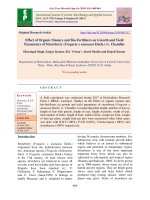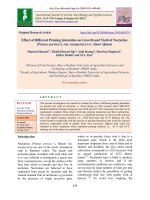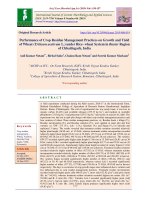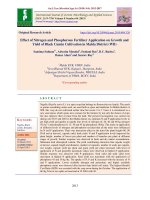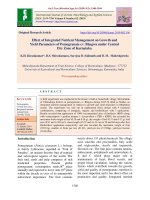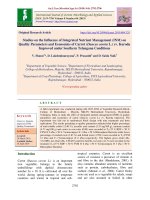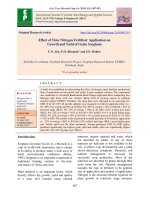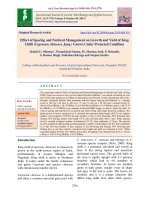Studies on the effect of integrated nutrient management (INM) on growth and yield parameters of carrot (Daucas carota L.) cv. Kuroda improved under southern Telangana conditions
Bạn đang xem bản rút gọn của tài liệu. Xem và tải ngay bản đầy đủ của tài liệu tại đây (214.16 KB, 6 trang )
Int.J.Curr.Microbiol.App.Sci (2019) 8(4): 2786-2791
International Journal of Current Microbiology and Applied Sciences
ISSN: 2319-7706 Volume 8 Number 04 (2019)
Journal homepage:
Original Research Article
/>
Studies on the Effect of Integrated Nutrient Management (INM) on Growth
and Yield Parameters of Carrot (Daucas carota L.) cv. Kuroda Improved
under Southern Telangana Conditions
V. Shanu1*, D. Lakshminarayana2, P. Prasanth2 and D. Saida Naik3
1
Department of Vegetable Science, 2Department of Floriculture and Landscaping,
College of Horticulture, Mojerla, SKLTS Horticultural University, Rajendranagar,
Hyderabad – 500032, India
3
Department of Crop Physiology, College of Agriculture, PJTS Agricultural University,
Rajendranagar, Hyderabad – 500032, India
*Corresponding author
ABSTRACT
Keywords
Carrot cv. Kuroda
improved, INM,
Growth, Yield
Article Info
Accepted:
20 March 2019
Available Online:
10 April 2019
A field experiment was conducted during rabi 2017-2018 at Vegetable Research Block,
College of Horticulture – Mojerla, SKLTS Horticultural University, Hyderabad,
Telangana, India, to study the effect of integrated nutrient management (INM) on growth
and yield parameters of carrot (Daucas carota L.) cv. Kuroda improved. The experiment
was carried out with the nine integrated nutrient management treatments i.e. T 1 - RDF
(NPK @ 50:40:50 kg/ha), T 2 - FYM 12 t/ha, T3 - Vermicompost @ 6 t/ha, T4-Rhizosphere Bacteria (AZB + PSB each @ 7 kg/ha), T 5 - 50 % RDF + 50 % FYM @ 6
t/ha, T6 - 50 % RDF + 50 % Vermicompost @ 3 t/ha, T 7 - 50 % RDF + 50 % Rhizosphere
Bacteria, T8 - 25 % RDF + 50 % FYM @ 6 t/ha + 50%Vermicompost @ 3 t/ha, T 9 - 25 %
RDF + 50 % FYM @ 6 t/ha + 50 % Vermicompost @ 3 t/ha + 50 % Rhizosphere Bacteria,
in Randomized Block Design and replicated thrice. Among the treatments, T 9 (25 % RDF
+ 50 % FYM @ 6 t/ha + 50 % Vermicompost @ 3 t/ha + 50 % Rhizosphere Bacteria)
registered significantly higher plant height (53.50 cm), more number of leaves per plant
(16.40), maximum leaf length (38.20 cm) and fresh weight of leaves (62.46 g), least
number of days taken to harvest (75.33 days), maximum root length (19.76 cm), root
diameter (3.96 cm), fresh weight of root (81.33 g), root yield per plot (5.60 kg) and root
yield per hectare (18.60 t).
Introduction
Carrot (Daucus carota L.) is an important
root vegetable, belongs to the family
umbelliferae with diploid chromosome
number 2n = 18. It is cultivated all over the
world, during spring-summer in temperate
countries and winter in tropical and subtropical countries. Carrot is an excellent
source of carotene a precursor of vitamin A
and fibre in the diet (Handelman, 2001). It
also contains abundant amounts of nutrients
2786
Int.J.Curr.Microbiol.App.Sci (2019) 8(4): 2786-2791
such as protein, carbohydrates, fibre and
sodium (Ahmad et al., 2004). Carrot fleshy
roots are used as a vegetable for salads, soups
and are also steamed or boiled in other
vegetable dishes (Amjad et al., 2005). Besides
the food value it has, different parts of carrot
can be used for different medicinal purposes
due to a wide range of reported
pharmacological effects (Rossi et al., 2007).
Carrot is a heavy feeder of nutrients, which
removes 100 kg N, 50 kg P2O5 and 180 kg
K2O per hectare and is very sensitive to
nutrient and soil moisture (Sunanda Rani and
MallaReddy, 2007). Nowadays Chemical
fertilizers are the main source of nutrients
used for carrot cropping. However,
continuous dependence on chemical fertilizers
causes nutritional imbalance and adverse
effects on physico-chemical and biological
properties of the soil. Integrated nutrient
management (INM) is a better approach for
supplying nutrition to the crop by including
organic and inorganic sources of nutrients.
Thus a combined use of organic manures,
biofertilizers with a reduced dose of chemical
fertilizers, not only pave the way for higher
yield and quality produce but also help to
maintain the soil health and reduce pollution
problems. Keeping the facts in view, the
present investigation was planned to find out
the effect of integrated nutrient management
on growth and yield parameters of carrot
under Southern Telangana conditions.
Materials and Methods
The present investigation was conducted to
study the effect of integrated nutrient
management (INM) on growth and yield of
carrot (Daucas carota L.) cv. Kuroda
improved
under
Southern
Telangana
conditions at Vegetable Research Block,
College of Horticulture - Mojerla, SKLTS
Horticultural
University,
Hyderabad
(Telangana) situated at 780 29' East longitude
and 170 19' North latitude with an altitude of
542.3 m above the mean sea level. The
location is characterized by semi arid climate.
The carrot variety Kuroda improved used as
experimental material and experiment was
laid out in a randomized block design with
nine treatments having three replications. The
soil of the experimental site was sandy loam
having soil pH 6.5, organic carbon 0.27 %
and available N, P and K content of 206,
26.00 and 220 kg ha-1 respectively. The total
nine treatments consist of T1 - RDF (NPK @
50:40:50 kg/ha), T2 - FYM 12 t/ha, T3 Vermicompost @ 6 t/ha, T4- Rhizosphere
Bacteria (AZB + PSB each @ 7 kg/ha), T5 -50
% RDF + 50 % FYM @ 6 t/ha, T6 – 50 %
RDF + 50 % Vermicompost @ 3 t/ha, T7 - 50
% RDF + 50 % Rhizosphere Bacteria, T8 - 25
% RDF + 50 % FYM @ 6 t/ha +
50%Vermicompost @ 3 t/ha, T9 - 25 % RDF
+ 50 % FYM @ 6 t/ha + 50 % Vermicompost
@ 3 t/ha + 50 % Rhizosphere Bacteria. N, P
and K were given through Urea, SSP and
MOP respectively. Full dose of P and K and
half dose of N were applied as basal dose, as
per treatment before sowing and remaining
half dose of N was given 30 days after
sowing.
Manures
viz.,
FYM
and
vermicompost were incorporated as per
treatment to respective plots prior to sowing.
Biofertilizers (Azotobacter and PSB) were
inoculated to seeds prior to sowing as seed
treatment method. Seeds were sown at the
spacing of 30 x 5cm and thinning was done
10 days after sowing to maintain spacing. The
data were recorded on five plants per
treatment per plot in each replication on
growth and yield parameters. Observations
were recorded on plant height, number of
leaves per plant, leaf length, fresh weight of
leaves time taken to first harvest, root length,
root diameter, fresh weight of root, root yield
per plot, root yield per hectare. The data were
statistically analysed using analysis of
variance (ANOVA) for RBD following the
standard procedure as suggested by Panse and
Sukhatme (1985).
2787
Int.J.Curr.Microbiol.App.Sci (2019) 8(4): 2786-2791
number of leaves per plant and maximum leaf
length. Similar results were also reported by
Singh et al., (2017), Kirad et al., (2010) and
Vithwel Kanaujia (2013) in carrot.
Results and Discussion
Growth parameters
Integrated
nutrient
management
had
significant effect on growth parameters of
carrot (Table 1 & 2). Among the treatments,
T9 treatment (25 % RDF + 50 % FYM @ 6
t/ha + 50 % Vermicompost @ 3 t/ha + 50 %
Rhizosphere Bacteria) registered significantly
higher plant height (53.50 cm), more number
of leaves per plant (16.40), maximum leaf
length (38.20 cm) and fresh weight of leaves
(62.46 g) at harvest stage.
Maximum fresh weight of leaves might be
due to higher plant height, more number of
leaves and maximum leaf area of this
treatment as compared to the rest of
treatments. The results are comparable with
those of Singh et al., (2017), Kirad et al.,
(2010) in carrot and Khalid et al., (2015) in
radish.
Yield parameters
The maximum increase in plant height was
due to readily availability of required
quantities of nitrogen, which is being a
constituent of amino acids, nucleotides,
nucleic acids, a number of coenzymes, auxins,
cytokinins and alkaloids, resulted in increased
cell elongation, cell enlargement and cell
division. Moreover the higher plant height
could be due to certain growth promoting
substances secreted by the biofertilizers i.e.,
Azotobacter and phosphate solubilizing
bacteria, which in turn, might have led to
better root development, better transportation
of water, uptake and deposition of nutrients.
The results are in accordance with the
findings of Singh et al., (2017) and Kirad et
al., (2010) in carrot.
More number of leaves per plant and
maximum leaf length could be due to timely
supply of all nutrients resulted in luxurious
vegetative growth of plant. Moreover
application of FYM and vermicompost helped
in development of the physical, chemical and
biological properties of soil which helps in
better nutrient absorption and utilization by
plant. Seed inoculation of biofertilizers might
have helped to increase the biological
nitrogen fixation and availability of
phosphorous required for strong vegetative
growth, ultimately led to production of more
The experimental results revealed that the
yield parameters were significantly influenced
by various treatments (Table 3). The mean
number of days taken to harvest was found to
be significant in all the treatments. Minimum
number of days taken to harvest was recorded
in T9 (25 % RDF + 50 % FYM @ 6 t/ha + 50
% Vermicompost @ 3 t/ha + 50 %
Rhizosphere Bacteria) (75.33 days) and it was
on par with T8 (25 % RDF + 50 % FYM @ 6
t/ha + 50 % Vermicompost @ 3 t/ha) (76.66
days). These results are due to the better plant
growth, resulted in accelerated photosynthesis
and translocation of photosynthates towards
the root portion led to early physiological
maturity rather than other treatments. The
present investigation was inconsistent with
the reports of Kushwah et al., (2016) in radish
and Yogita et al., (2012) in onion.
Root length and diameter was found to be
significantly different among all the
treatments. Maximum root length and
diameter (19.76 cm and 3.96 cm) were
recorded under T9 (25 % RDF + 50 % FYM
@ 6 t/ha + 50 % Vermicompost @ 3 t/ha + 50
% Rhizosphere Bacteria) which was at par
with T8 (25 % RDF + 50 % FYM @ 6 t/ha +
50 % Vermicompost @ 3 t/ha). Higher
vegetative
growth
under
integrated
2788
Int.J.Curr.Microbiol.App.Sci (2019) 8(4): 2786-2791
application of nutrients might have helped in
synthesis of greater amount of food materials
which was later translocated into developing
root resulting in increased root length and root
diameter. Similarly maximum fresh weight of
root (81.33 g) was also recorded under
treatment T9 (25 % RDF + 50 % FYM @ 6
t/ha + 50 % Vermicompost @ 3 t/ha + 50 %
Rhizosphere Bacteria) which was on par with
T8. This might be due to higher root length
and root diameter. These results are
comparable with the reports of Vithwel
Kanaujia (2013) in carrot and Khalid et al.,
(2015) in radish.
Table.1 Effect of integrated nutrient management on plant height (cm) and number of leaves per
plant at different growth stages of carrot cv. Kuroda improved
Treatment
Plant height (cm)
Number of leaves per plant
30 DAS
60 DAS
At harvest
30 DAS
60 DAS
At harvest
c
c
c
c
c
14.10
31.00
45.43
4.50
10.93
13.50 c
T1
10.00 f
20.33 f
28.00 f
2.83 f
5.80 f
8.66 f
T2
d
e
e
e
e
12.76
24.83
35.00
3.23
7.93
10.33 e
T3
e
e
e
e
e
11.36
23.00
33.00
3.20
7.10
9.96 e
T4
cd
d
d
d
d
13.26
28.00
39.33
3.73
9.33
11.86 d
T5
cd
d
d
d
d
13.83
28.40
41.66
4.00
9.63
12.16 d
T6
13.60 cd
28.33 d
40.00 d
3.80 d
9.60 d
12.00 d
T7
b
b
b
b
b
15.60
33.80
49.56
5.13
12.33
15.06 b
T8
a
a
a
a
a
17.06
36.66
53.50
5.83
13.83
16.40 a
T9
1.31
2.55
3.68
0.47
1.26
1.20
CD at 5%
0.43
0.85
1.22
0.15
0.42
0.4
SEm±
Note: T1 - RDF (NPK @ 50:40:50 kg/ha), T 2 - FYM 12 t/ha, T3 - Vermicompost @ 6 t/ha, T4- Rhizosphere Bacteria
(AZB + PSB each @ 7 kg/ha), T5 -50 % RDF + 50 % FYM @ 6 t/ha, T 6 – 50 % RDF + 50 % Vermicompost @ 3
t/ha, T7 - 50 % RDF + 50 % Rhizosphere Bacteria, T 8 - 25 % RDF + 50 % FYM @ 6 t/ha + 50%Vermicompos @ 3
t/ha, T9 - 25 % RDF + 50 % FYM @ 6 t/ha + 50 % Vermicompost @ 3 t/ha + 50 % Rhizosphere Bacteria.
Table.2 Effect of integrated nutrient management on leaf length (cm) and fresh weight of leaves
(g) at different growth stages of carrot cv. Kuroda improved
Treatment
T1
T2
T3
T4
T5
T6
T7
T8
T9
CD at 5%
SEm±
Leaf length (cm)
30 DAS
8.16 c
5.06 f
6.23 e
5.60 ef
7.16 d
7.30 cd
7.20 d
9.60 b
11.03 a
0.92
0.30
60 DAS
22.06 c
12.66 f
17.90 e
16.00 e
19.86 d
20.13 d
20.00 d
24.00 b
26.63 a
1.92
0.64
Fresh weight of leaves (g)
At harvest
32.36 c
19.63 f
25.00 e
22.66 e
28.66 d
29.40 d
29.00 d
35.33 b
38.20 a
2.84
0.94
30 DAS
4.53 c
2.00 f
2.87 e
2.57 ef
3.63 d
3.90 d
3.73 d
5.13 b
5.86 a
0.57
0.19
60 DAS
40.20 b
24.00 f
28.20 e
27.73 e
32.66 d
36.00 c
34.66 cd
43.66 a
46.50 a
3.26
1.08
At harvest
51.66 b
34.57 e
39.00 d
38.56 de
43.33 c
45.00 c
44.66 c
58.00 a
62.46 a
4.19
1.39
Note: T1 - RDF (NPK @ 50:40:50 kg/ha), T 2 - FYM 12 t/ha, T3 - Vermicompost @ 6 t/ha, T4- Rhizosphere Bacteria
(AZB + PSB each @ 7 kg/ha), T 5 -50 % RDF + 50 % FYM @ 6 t/ha, T 6 – 50 % RDF + 50 % Vermicompost @ 3
t/ha, T7 - 50 % RDF + 50 % Rhizosphere Bacteria, T 8 - 25 % RDF + 50 % FYM @ 6 t/ha + 50%Vermicompos @ 3
t/ha, T9 - 25 % RDF + 50 % FYM @ 6 t/ha + 50 % Vermicompost @ 3 t/ha + 50 % Rhizosphere Bacteria.
2789
Int.J.Curr.Microbiol.App.Sci (2019) 8(4): 2786-2791
Table.3 Effect of INM on yield parameters of carrot cv. Kuroda improved
Treatment
Time taken
Root length
Root
Fresh
Root yield
Root yield
to first
(cm)
diameter
weight of
(kg/plot)
(t/ha)
harvest
(cm)
root (g)
(days)
b
79.33
17.50 b
3.73 a
74.23 b
4.33 c
14.43 c
T1
e
e
d
e
f
87.00
12.17
2.23
44.33
2.26
7.53 f
T2
85.33 e
14.00 d
2.66 c
53.33 d
2.83 e
9.43 e
T3
e
d
c
de
ef
86.66
13.66
2.73
49.66
2.63
8.76 ef
T4
d
c
b
c
d
83.33
15.66
3.16
62.66
3.60
12.00 d
T5
c
c
b
c
d
81.33
15.80
3.26
67.73
3.80
12.66 d
T6
cd
c
b
c
d
83.00
15.73
3.20
64.33
3.70
12.33 d
T7
76.66 a
18.33 ab
3.80 a
78.00 ab
4.96 b
16.53 b
T8
a
a
a
a
a
75.33
19.76
3.96
81.33
5.60
18.60 a
T9
1.98
1.48
0.37
6.32
0.47
1.40
CD at 5%
0.66
0.49
0.12
2.10
0.15
0.46
SEm±
Note: T1 - RDF (NPK @ 50:40:50 kg/ha), T 2 - FYM 12 t/ha, T3 - Vermicompost @ 6 t/ha, T4- Rhizosphere Bacteria
(AZB + PSB each @ 7 kg/ha), T 5 -50 % RDF + 50 % FYM @ 6 t/ha, T 6 - 50 % RDF + 50 % Vermicompost @ 3
t/ha, T7 - 50 % RDF + 50 % Rhizosphere Bacteria, T 8 - 25 % RDF + 50 % FYM @ 6 t/ha + 50%Vermicompos @ 3
t/ha, T9 - 25 % RDF + 50 % FYM @ 6 t/ha + 50 % Vermicompost @ 3 t/ha + 50 % Rhizosphere Bacteria.
Significant difference observed among the
treatments with respect to root yield per plot
and yield per hectare. Among the treatments,
T9 (25 % RDF + 50 % FYM @ 6 t/ha + 50 %
Vermicompost @ 3 t/ha + 50 % Rhizosphere
Bacteria) reported significantly maximum
root yield per plot and yield per hectare (5.60
kg and 18.60 t/ha respectively). These results
are due to the maximum fresh weight of root
of this treatment as compared to rest of the
treatments. These findings are in line with the
reports of Singh et al., (2017), Kirad et al.,
(2010), Vithwel Kanaujia (2013) in carrot and
Khalid et al., (2015) in radish.
References
Ahmad, B., Bakhsh, K. and Hassan, S. 2004.
Economics of growing carrot, Faculty
of Agricultural Economics and R.S.,
University of Agriculture, Faisalabad. A
report
submitted
to
Pakistan
Agricultural Research Council (PARC),
Islamabad, Pakistan.
Amjad, M., Naz, S. and Ali, S. 2005. Growth
and seed yield of carrot as influenced by
different regimes of nitrogen and
potassium. J. Res. Sci. 16 (2): 73-78.
Handelman. G.J. 2001. The evolving role of
carotenoids in human biochemistry.
Nutrition, 17:818-822.
Khalid, M., Yadav, M.P., Amar, S. and
Yadav, B.K. 2015. Studies on the effect
of Integrated nutrient management on
growth and yield attributing characters
of radish (Raphanus sativus L.). Annals
of Horticulture. 8(1):81-83.
Kirad, K. S., Barch, S. and Singh, D. B. 2010.
Integrated nutrient management on
growth, yield and quality of carrot.
Karnataka J. Agric. Sci. 23 (3): 542-543
Kushwah. L. 2016. Effect of organic manures,
inorganic
fertilizers
and
their
combinations on growth, yield and
quality of radish (Raphanus sativus L.).
M.Sc. (Horti.). Thesis submitted to
RVSKVV, Mandsaur (M.P.)
Panse, V. G. and Sukhatme, P. V. 1967.
Statistical methods for Agricultural
workers. Indian Council of Agricultural
Research, New Delhi.
Rossi, P. G., Bao, L., Luciani, A., Panighi, J.,
2790
Int.J.Curr.Microbiol.App.Sci (2019) 8(4): 2786-2791
Desjober, J. M., Bolla, J. J. and Berti, L.
2007. E-methylisoeugenol and elemicin:
antibacterial components of Daucus
carota L. essential oil against
Campylobacter jejuni. Journal of
Agricultual and Food Chemistry.
55:7332-7336.
Singh, D. P., Kumar, S., Sutanu, M. and
Vijay, P. K. 2017. Studies on integrated
nutrient management on growth, yield
and quality of carrot (Daucus carota
L.). International Journal of Agriculture
Sciences. 51(8): 2187-2188.
Sunandarani, N., Mallareddy, K. 2007. Effect
of different organic manures and
inorganic fertilizers on growth, yield
and quality of carrot (Daucus carota
L.). Karnataka Journal of Agricultural
Sciences. 20 (3): 686-688.
Vithwel Kanaujia, S.P. 2013. Integrated
nutrient management on productivity of
carrot and fertility of soil. SAARC
Journal of Agriculture. 11 (2): 173-181.
Yogita, Ram, R. B. and Babu, M. 2012. Effect
of inorganic and biofertilizers on
growth and yield of onion (Allium cepa
L.) cv. Pusa Madhavi. Plant Archives.
12(2): 645-648.
How to cite this article:
Shanu, V., D. Lakshminarayana, P. Prasanth and Saida Naik, D. 2019. Studies on the Effect of
Integrated Nutrient Management (INM) on Growth and Yield Parameters of Carrot (Daucas
carota L.) cv. Kuroda Improved under Southern Telangana Conditions.
Int.J.Curr.Microbiol.App.Sci. 8(04): 2786-2791. doi: />
2791
